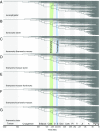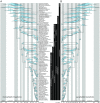The timescale of early land plant evolution
- PMID: 29463716
- PMCID: PMC5877938
- DOI: 10.1073/pnas.1719588115
The timescale of early land plant evolution
Abstract
Establishing the timescale of early land plant evolution is essential for testing hypotheses on the coevolution of land plants and Earth's System. The sparseness of early land plant megafossils and stratigraphic controls on their distribution make the fossil record an unreliable guide, leaving only the molecular clock. However, the application of molecular clock methodology is challenged by the current impasse in attempts to resolve the evolutionary relationships among the living bryophytes and tracheophytes. Here, we establish a timescale for early land plant evolution that integrates over topological uncertainty by exploring the impact of competing hypotheses on bryophyte-tracheophyte relationships, among other variables, on divergence time estimation. We codify 37 fossil calibrations for Viridiplantae following best practice. We apply these calibrations in a Bayesian relaxed molecular clock analysis of a phylogenomic dataset encompassing the diversity of Embryophyta and their relatives within Viridiplantae. Topology and dataset sizes have little impact on age estimates, with greater differences among alternative clock models and calibration strategies. For all analyses, a Cambrian origin of Embryophyta is recovered with highest probability. The estimated ages for crown tracheophytes range from Late Ordovician to late Silurian. This timescale implies an early establishment of terrestrial ecosystems by land plants that is in close accord with recent estimates for the origin of terrestrial animal lineages. Biogeochemical models that are constrained by the fossil record of early land plants, or attempt to explain their impact, must consider the implications of a much earlier, middle Cambrian-Early Ordovician, origin.
Keywords: Embryophyta; evolution; phylogeny; plant; timescale.
Copyright © 2018 the Author(s). Published by PNAS.
Conflict of interest statement
The authors declare no conflict of interest.
Figures





Comment in
-
Reply to Hedges et al.: Accurate timetrees do indeed require accurate calibrations.Proc Natl Acad Sci U S A. 2018 Oct 9;115(41):E9512-E9513. doi: 10.1073/pnas.1812816115. Epub 2018 Sep 28. Proc Natl Acad Sci U S A. 2018. PMID: 30266794 Free PMC article. No abstract available.
-
Accurate timetrees require accurate calibrations.Proc Natl Acad Sci U S A. 2018 Oct 9;115(41):E9510-E9511. doi: 10.1073/pnas.1812558115. Epub 2018 Sep 28. Proc Natl Acad Sci U S A. 2018. PMID: 30266795 Free PMC article. No abstract available.
References
-
- Algeo TJ, Scheckler SE. Terrestrial-marine teleconnections in the Devonian: Links between the evolution of land plants, weathering processes, and marine anoxic events. Philos Trans R Soc Lond B Biol Sci. 1998;353:113–128.
-
- Morris JL, et al. Investigating Devonian trees as geo-engineers of past climates: Linking palaeosols to palaeobotany and experimental geobiology. Palaeontology. 2015;58:787–801.
-
- Berner RA, Kothavala Z. GEOCARB III: A revised model of atmospheric CO2 over Phanerozoic time. Am J Sci. 2001;301:182–204.
-
- Berner RA. GEOCARBSULF: A combined model for Phanerozoic atmospheric O2 and CO2. Geochim Cosmochim Acta. 2006;70:5653–5664.
-
- Bergman NM, Lenton TM, Watson AJ. COPSE: A new model of biogeochemical cycling over Phanerozoic time. Am J Sci. 2004;304:397–437.
Publication types
MeSH terms
Associated data
Grants and funding
LinkOut - more resources
Full Text Sources
Other Literature Sources

